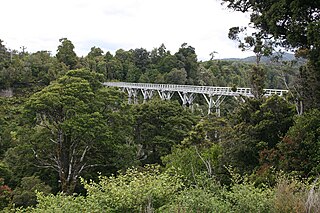
Percy Burn Viaduct is located in the far south of the South Island of New Zealand. It is reputedly the largest surviving wooden viaduct in the world. A former logging tramway, it is now a footbridge and the most popular feature of the Tuatapere Hump Ridge Track.
The Tokanui Branch, also known as the Seaward Bush Branch, was a branch line railway located in Southland, New Zealand. It diverged from the Bluff Branch south of the main railway station in Invercargill and ran for 54 kilometres in a southeasterly direction. Construction began in 1883 and it operated until 1966.

The Hump Ridge Track, also called the Tuatapere Hump Ridge Track, is a 61 km walking track that is partly in Fiordland National Park in New Zealand. The track was opened in 2001 and is run privately on behalf of the Tuatapere Hump Ridge Track Charitable Trust.

The Stillwater Ngākawau Line (SNL), formerly the Stillwater–Westport Line (SWL) and the Ngakawau Branch, is a secondary main line, part of New Zealand's national rail network. It runs between Stillwater and Ngakawau via Westport on the West Coast of the South Island. It was one of the longest construction projects in New Zealand's history, with its first section, at the south end, opened in 1889, and the beginnings of the Ngākawau Branch, at its Westport end, in 1875. The full line was completed in 1942. The only slower railway projects were Palmerston North to Gisborne, 1872 to 1942, and the Main North Line to Picton, 1872 to 1945.
Fortification is a locality in the western part of the Catlins region of Southland in New Zealand's South Island. Nearby settlements include Quarry Hills and Waikawa to the southeast, Tokanui to the southwest, and Waimahaka to the west. It is over 50 km east of Southland's main centre, Invercargill.

The Big River has also been known by several other names, Windsor River and Māori names Hakapoua, Okopowa, Patu-po, or Patupō, though that last name, meaning kill by night, might refer to a place near Long Point and Waitutu. It is a river of southern Fiordland, New Zealand, and is one of three rivers of that name in the South Island. It is the main source of Lake Hakapoua and a lower stretch is the lake's 2-kilometre (1.2 mi) outflow to the sea. The river rises on the 1,123 m (3,684 ft) high Arnett Peak, in the Cameron Mountains, runs about 23 km (14 mi) to the lake. At about the mid point of the river it runs through a narrow gorge. Elsewhere it is generally very shallow. The river is in the Fiordland National Park.
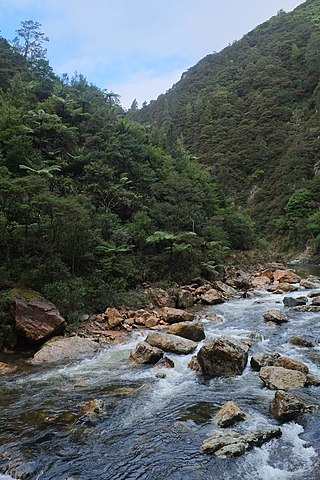
The Waitawheta River is a river of the Waikato Region of New Zealand's North Island. It flows from a point south-east of Mount Te Aroha in the Kaimai Range to the Karangahake Gorge at the foot of the Coromandel Peninsula to reach the Ohinemuri River at Karangahake, five kilometres east of Paeroa.

Edmund Giblett Allen (1844–1909) was a Liberal Party Member of Parliament in New Zealand.

John Henry Davis Burnand, known as Harry Burnand, was a New Zealand engineer and sawmiller. He was born in London, England on 2 December 1850.

The Port Craig tramway was an overall 24.4 kilometres (15.2 mi) long, bush tramway with a gauge of 3 ft 6 in at Port Craig in New Zealand, which operated from 1917 to 1928.
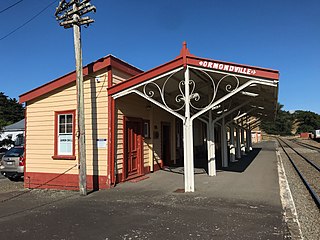
Ormondville is a locality in the Manawatū-Whanganui region of New Zealand's North Island. It is located inland, south of Waipukurau and west of Flemington, Hawke's Bay.
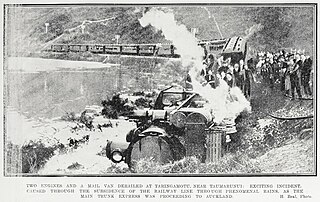
Taringamotu railway station was a station at Taringamotu on the North Island Main Trunk, in the Ruapehu District and Manawatū-Whanganui region.

Mangapehi was a flag station on the North Island Main Trunk line, in the Waitomo District of New Zealand. It was 5.89 km (3.66 mi) north of Poro-O-Tarao and 5.15 km (3.20 mi) south of Kopaki.

Hīhītahi was a station on the North Island Main Trunk line, in the Rangitikei District of New Zealand, in the Hautapu River valley. The station served the settlement of Hīhītahi, which was big enough to have a store and a school. It was 12.55 km (7.80 mi) south of Waiouru and 3.05 km (1.90 mi) north of Turangarere. Hīhītahi is at the top of a 1 in 70 gradient from Mataroa, so that it is 39 m (128 ft) above Turangarere, but only 73 m (240 ft) below the much more distant Waiouru. A crossing loop remains.

Tangiwai was a station on the North Island Main Trunk line, in the Ruapehu District of New Zealand. The station served the settlement of Tangiwai. The nearby pulp and saw mills are now one of the main sources of freight on NIMT. In 1953 the Tangiwai disaster occurred when the nearby bridge over the Whangaehu River was swept away.

Karioi was a station on the North Island Main Trunk line, in the Ruapehu District of New Zealand. A passing loop remains.

Rangataua was a station on the North Island Main Trunk line, in the Ruapehu District of New Zealand. Like most of the stations on the central part of the NIMT, a large timber trade exploited the native bush until it was largely felled. What is now the small village of Rangataua developed to the south of the station. Just a single track now passes through and virtually nothing remains of the once busy station and workshops.

George Holdship (1839–1923) emigrated to Auckland in 1855 and became a businessman, mainly involved in timber logging and sawmills. His companies removed much of North Island’s native forest, initially kauri and later kahikatea. He moved to Sydney in 1913.
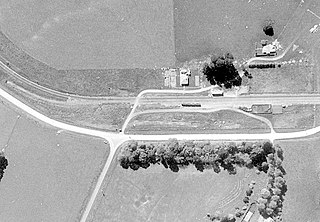
Kopua in New Zealand is now a sparsely populated area, immediately south of the border of the Manawatū-Whanganui and Hawke's Bay regions, with 150 people scattered over a 40 km2 (15 sq mi) meshblock. For two years it briefly flourished as a village, centred on a railway station on the Palmerston North–Gisborne line, opened on 25 January 1878, when it became the southern terminus of the line from Napier and Spit. Building to the south was delayed by the need to erect 3 large viaducts over the Manawatū River and its tributaries, so the extension to Makotuku didn't open until 9 August 1880. Kopua then declined until the station closed on 8 May 1977. Only a single line now passes through the station site and there are remnants of cattle yards.

Piripiri is a sparsely populated area in the Tararua District, in the Manawatū-Whanganui Region, on State Highway 2 and the Palmerston North–Gisborne line. It is 3 mi 8 ch (5.0 km) north of Dannevirke, and has 150 people scattered over a meshblock of 21.8 km2 (8.4 sq mi).




















